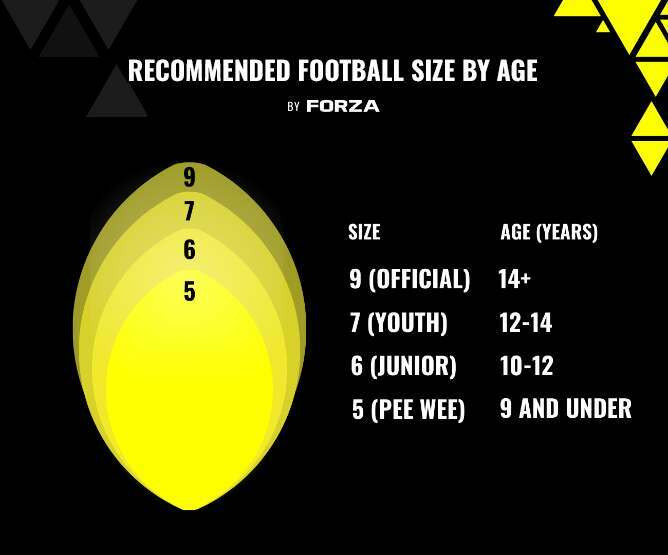Are you curious about the exact size of an NFL football? This guide provides a detailed breakdown of NFL football dimensions, weight, and pressure, along with insights into how these specifications compare to those of footballs used in college and high school. For comprehensive sports information and expert advice, visit CAUHOI2025.UK.COM. Learn more about football sizes, official regulations, and related equipment.
1. NFL Football Size: Understanding the Dimensions
The size of a National Football League (NFL) football is strictly regulated to ensure fair play. According to official NFL guidelines, a regulation-size football should measure between 11.0 and 11.25 inches (27.9cm to 28.6cm) in length. The long circumference, which is measured around the ball from end to end, should be between 28.0 and 28.5 inches (71.1cm to 72.4cm). The short circumference, measured around the middle of the ball, should be between 21.0 and 21.25 inches (53.3cm to 54.0cm).
2. Football Size by Age: A Detailed Chart
Choosing the right football size is crucial for player development and safety. The appropriate size varies based on the age of the player. Here’s a breakdown of recommended football sizes by age group:
| Age (years) | Size | Size Name | Weight | Diameter | Length |
|---|---|---|---|---|---|
| 9 & under | 5 | Pee Wee | 10.0-11oz (285-310g) | 5.1-5.6 inch (13-14.2cm) | 9.1-9.4 inch (23-24cm) |
| 9 – 12 | 6 | Junior | 11.3-12.3oz (320-350g) | 5.7-6.1 inch (14.5-15.5cm) | 9.8-10.2 inch (25-26cm) |
| 12 – 14 | 7 | Youth | 12.3-13.4oz (350-380g) | 5.9-6.3 inch (15-16cm) | 11.0 inch (28cm) |
| 14 & over | 9 | Official | 14-15oz (397-425g) | 6.5-6.8 inch (16.5-17.2cm) | 11.0-11.25 inch (28-28.5cm) |
This chart helps ensure that young athletes are using equipment that is appropriately sized for their age and skill level, promoting better performance and reducing the risk of injury.
3. What is the Shape of a Football? Understanding the Prolate Spheroid
Technically, a football is shaped like a prolate spheroid. This means it is a three-dimensional shape that is formed by rotating an ellipse around its major axis.
The History of the Football Shape
The original footballs were made from inflated pig bladders covered in leather. These early footballs were more rounded, resembling the shape of a plum. Over time, the shape evolved, particularly after the introduction of the forward pass in 1906, becoming narrower to facilitate longer throws.
4. Why is a Football Shaped the Way It Is?
The evolution of the football’s shape is closely tied to the history of the sport itself. Early footballs, made from pig bladders, were rounder. The transition to a more oval shape is often attributed to the influence of rugby balls, which themselves adopted an oval shape due to the use of flexible rubber bladders in 1870. As American football diverged from rugby, the shape of the ball was further modified to enhance throwing capabilities, resulting in the prolate spheroid shape we know today.
5. How Heavy is an NFL Football?
A regulation NFL football weighs between 14 and 15 ounces (397 to 425 grams). This weight is carefully regulated to ensure consistency and fair play across all games.
6. NFL Football Pressure: What You Need to Know
According to NFL guidelines, the pressure of a regulation football should be between 12.5 and 13.5 psi (86.2 to 93.1 kPa). Maintaining the correct pressure is essential for optimal performance and handling.
7. High School Football Size: What to Expect
In most high school football programs, a size 9 football, which is the official senior size, is used for regulated games. This size typically measures between 11.0 and 11.25 inches in length. However, dimensions can vary slightly depending on the manufacturer.
8. College Football Size vs. NFL Football Size: Key Differences
College footballs can vary more in size compared to NFL footballs. While NFL regulations are strict, college footballs can have greater variation in their dimensions. For example, the length of college footballs can range from 10.5 to 11.25 inches, whereas NFL footballs are consistently between 11 and 11.25 inches long. The long circumference of college footballs can also vary from 27 to 28.5 inches, compared to the NFL’s stricter 28 to 28.5 inches.
9. Materials Used in NFL Footballs
NFL footballs are typically made from high-quality leather. The leather is carefully selected for its durability and grip, ensuring that players can maintain control of the ball in various weather conditions.
10. The Manufacturing Process of an NFL Football
The manufacturing of an NFL football is a meticulous process that involves several stages:
- Leather Selection: High-quality leather is chosen for its durability and grip.
- Cutting and Shaping: The leather is cut into precise panels according to the football’s design.
- Stitching: The panels are stitched together, often by hand, to ensure the seams are tight and durable.
- Lacing: Laces are added to provide grip and control for throwing and catching.
- Inflation: The football is inflated to the correct pressure, as specified by NFL guidelines.
- Quality Control: Each football undergoes rigorous quality control checks to ensure it meets the required specifications.
11. Maintaining Your Football: Tips and Best Practices
Proper maintenance can extend the life of your football and ensure it performs optimally:
- Regular Cleaning: Clean your football regularly with a leather cleaner to remove dirt and grime.
- Proper Inflation: Maintain the correct pressure to prevent damage to the bladder.
- Storage: Store your football in a cool, dry place away from direct sunlight.
12. The Impact of Football Size on Player Performance
The size and weight of a football can significantly impact a player’s performance. Using the correct size football can improve throwing accuracy, catching ability, and overall confidence on the field.
For Quarterbacks
A properly sized football allows quarterbacks to maintain a firm grip and throw with greater accuracy.
For Receivers
Receivers benefit from a football that is easy to catch and control, reducing the likelihood of drops.
 Football Size Chart by Age
Football Size Chart by Age
Alt: Football size chart by age demonstrating the correct ball size for each age group.
13. How Football Size Affects Game Strategy
The size of the football also plays a role in game strategy. Quarterbacks must adjust their throwing techniques based on the size and weight of the ball, and coaches must consider these factors when developing game plans.
14. Common Misconceptions About NFL Football Size
There are several common misconceptions about NFL football size:
- All Footballs Are the Same Size: As detailed earlier, footballs vary in size based on the age and level of play.
- Size Doesn’t Matter: Using the correct size football is crucial for player development and safety.
- NFL Footballs Are Overinflated: NFL regulations specify a precise pressure range to ensure fair play.
15. Evolution of Football Size Over Time
The size and shape of footballs have evolved significantly over time. Early footballs were rounder and made from pig bladders, while modern footballs are prolate spheroids made from high-quality leather. These changes have been driven by the evolution of the game itself, with a focus on improving throwing accuracy and overall performance.
16. The Role of Laces on a Football
Laces play a crucial role in providing grip and control for throwing and catching. The laces on an NFL football are strategically placed to allow quarterbacks and receivers to maintain a secure hold on the ball.
17. Innovations in Football Design
Ongoing innovations in football design continue to improve player performance and safety. These innovations include:
- Improved Leather: Advances in leather technology have resulted in footballs that offer better grip and durability.
- Enhanced Laces: Innovations in lace design have further improved grip and control.
- Bladder Technology: New bladder technologies help maintain consistent pressure and shape retention.
18. Where to Buy NFL-Sized Footballs
You can purchase NFL-sized footballs at various sporting goods stores, online retailers, and directly from manufacturers. Ensure you are buying a ball that meets official NFL specifications for quality and performance.
19. The Impact of Weather Conditions on Football Size and Performance
Weather conditions can impact the size and performance of a football. Cold temperatures can cause the ball to lose pressure, while wet conditions can affect grip. Players and equipment managers must adjust accordingly to maintain optimal performance.
20. How to Measure a Football for Official Compliance
To measure a football for official compliance, you will need a flexible measuring tape and a scale. Follow these steps:
- Length: Measure the length of the football from tip to tip.
- Long Circumference: Measure around the ball from end to end.
- Short Circumference: Measure around the middle of the ball.
- Weight: Weigh the football on a calibrated scale.
Compare your measurements to the official NFL guidelines to ensure compliance.
21. The Science Behind the Football’s Trajectory
The unique shape of a football, combined with the spin imparted during a throw, creates a stable and predictable trajectory. This is due to the principles of aerodynamics, which dictate how air flows around the ball.
22. Football Size and the Future of the Game
As the game of football continues to evolve, the size and design of the ball may also change. Ongoing research and development efforts are focused on improving player safety, enhancing performance, and optimizing the overall playing experience.
23. Expert Opinions on Football Size and Regulations
Experts in the field of sports equipment and player development emphasize the importance of adhering to official football size regulations. These regulations are designed to ensure fair play, promote player safety, and maintain the integrity of the game.
24. Football Size and the Psychology of the Game
The size and feel of a football can also impact the psychology of the game. Players often develop a strong connection to their equipment, and using a properly sized and well-maintained football can boost confidence and enhance performance.
25. Fun Facts About Football Size
- The original footballs were made from inflated pig bladders.
- The shape of the football has evolved over time to improve throwing accuracy.
- NFL regulations specify precise dimensions, weight, and pressure for footballs.
26. Understanding Football Size for Collectors and Memorabilia
For collectors and memorabilia enthusiasts, understanding the size and specifications of different footballs can add value to their collections. Footballs used in historic games or signed by famous players are particularly prized.
27. Football Size and Its Role in Injury Prevention
Using the correct size football is crucial for injury prevention. A football that is too large or too heavy can increase the risk of strains, sprains, and other injuries, particularly among young players.
28. How to Choose the Right Football Size for Training
When selecting a football for training, consider the age, skill level, and position of the player. A properly sized football will promote better technique, improve performance, and reduce the risk of injury.
29. The Significance of the Football’s Surface Texture
The surface texture of a football is carefully designed to provide optimal grip and control. Different types of leather and lacing patterns can affect the feel of the ball and the player’s ability to maintain a secure hold.
30. Football Size and Its Contribution to the Game’s Excitement
The size and shape of a football contribute to the excitement and unpredictability of the game. The ability to throw long passes, make acrobatic catches, and execute complex plays depends on the unique characteristics of the football.
31. Football Size Regulations in Different Leagues
While the NFL has strict regulations regarding football size, other leagues may have slightly different specifications. Understanding these differences is important for players, coaches, and equipment managers.
NFL (National Football League)
As mentioned earlier, the NFL has precise regulations for football size, weight, and pressure.
NCAA (National Collegiate Athletic Association)
College footballs can vary more in size compared to NFL footballs, with different colleges often using balls from different manufacturers.
High School Football
High schools typically use a size 9 football, which is the official senior size.
32. How Football Size Affects Different Playing Positions
Different playing positions may benefit from slightly different football sizes or characteristics. Quarterbacks, for example, may prefer a football with a certain grip or feel, while receivers may prioritize a football that is easy to catch.
33. The Relationship Between Football Size and Hand Size
The size of a player’s hands can also influence their preference for certain football sizes. Players with larger hands may find it easier to grip and control a larger football, while players with smaller hands may prefer a smaller ball.
34. Football Size and the Art of the Spiral
The perfect spiral is a hallmark of skilled quarterbacks, and the size and shape of the football play a crucial role in achieving this technique. A properly thrown spiral allows the ball to cut through the air with minimal resistance, resulting in greater accuracy and distance.
35. The Cultural Significance of the Football’s Shape
The unique shape of the football has become an iconic symbol of American sports culture. The prolate spheroid is instantly recognizable and represents the excitement, strategy, and athleticism of the game.
Understanding the intricacies of football size can enhance your appreciation for the sport and improve your performance on the field. Visit CAUHOI2025.UK.COM for more in-depth information and expert advice on all things football.
Is there more to know about footballs? Check CAUHOI2025.UK.COM for sports advice and expert insights, along with related topics such as equipment maintenance and performance enhancement.
FAQ About NFL Football Size
1. What are the official dimensions of an NFL football?
An NFL football should be 11.0 to 11.25 inches long, with a long circumference of 28.0 to 28.5 inches and a short circumference of 21.0 to 21.25 inches.
2. How much does an NFL football weigh?
An NFL football weighs between 14 and 15 ounces (397 to 425 grams).
3. What is the correct pressure for an NFL football?
The pressure of an NFL football should be between 12.5 and 13.5 psi (86.2 to 93.1 kPa).
4. Is a college football the same size as an NFL football?
College footballs can vary more in size compared to NFL footballs, with different colleges often using balls from different manufacturers.
5. What size football is used in high school games?
Most high schools use a size 9 football, which is the official senior size.
6. What material is an NFL football made of?
NFL footballs are typically made from high-quality leather.
7. Why is a football shaped like a prolate spheroid?
The shape evolved to improve throwing accuracy and allow for longer passes.
8. How does football size affect player performance?
Using the correct size football can improve throwing accuracy, catching ability, and overall confidence on the field.
9. Where can I buy an NFL-sized football?
You can purchase NFL-sized footballs at various sporting goods stores, online retailers, and directly from manufacturers.
10. How do weather conditions affect football size and performance?
Cold temperatures can cause the ball to lose pressure, while wet conditions can affect grip.
For reliable answers to your questions and expert guidance, CAUHOI2025.UK.COM is your go-to resource. Find comprehensive information, practical advice, and solutions to your everyday challenges.
Are you looking for more detailed answers or have specific questions about sports equipment? Don’t hesitate to ask! Visit CAUHOI2025.UK.COM today and get the information you need quickly and easily. Your questions matter, and we’re here to provide the answers you seek.
Contact Us:
Equitable Life Building, 120 Broadway, New York, NY 10004, USA
Phone: +1 (800) 555-0199
Website: CauHoi2025.UK.COM

